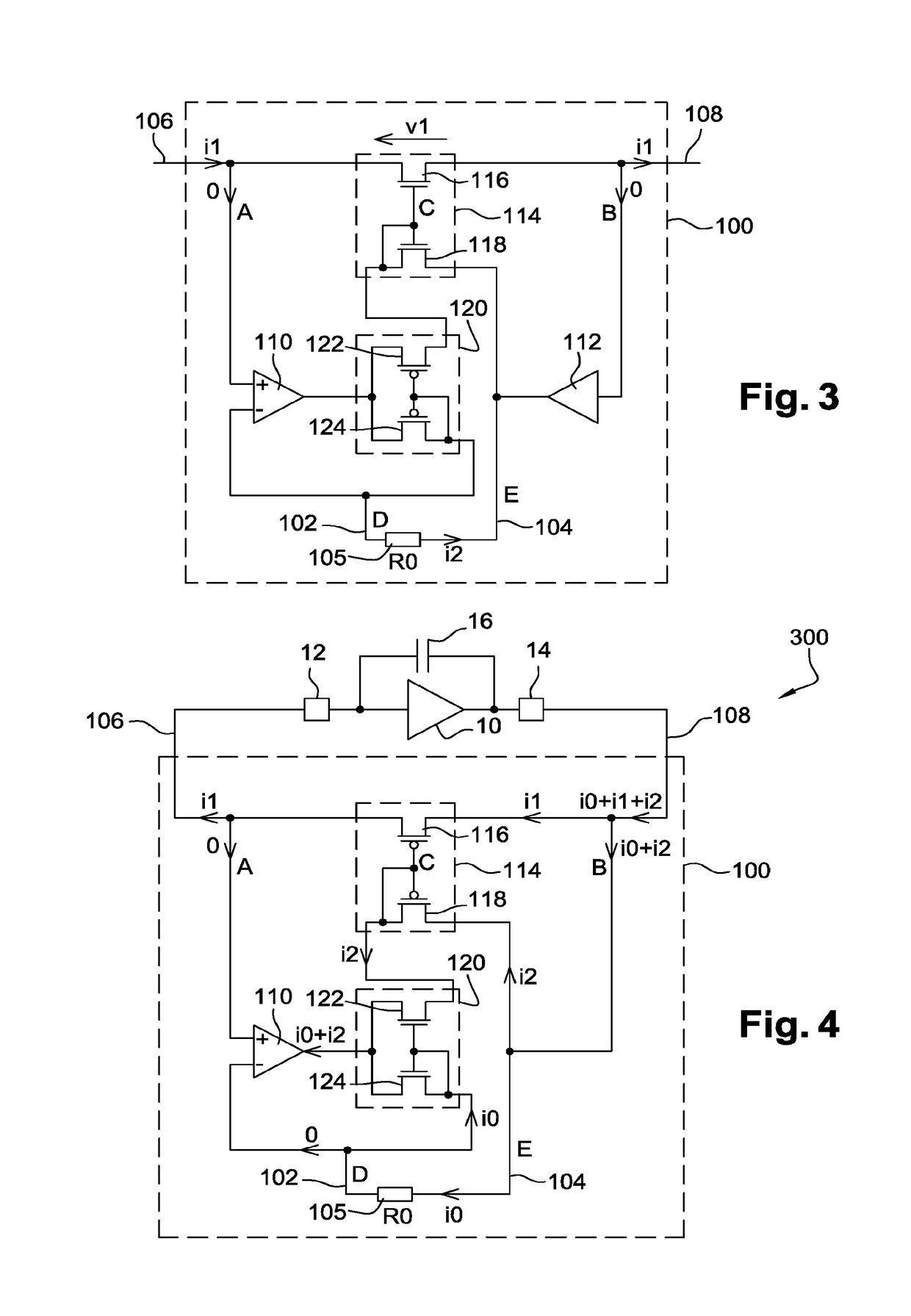Device modifying the impedance value of a reference resistor
a reference resistor and device technology, applied in the direction of network simulating resistances, electrical apparatus, electronic switching, etc., can solve the problems of stray, parasitic, stray, etc., and the device is not adapted to form hvr resistors,
- Summary
- Abstract
- Description
- Claims
- Application Information
AI Technical Summary
Benefits of technology
Problems solved by technology
Method used
Image
Examples
first embodiment
[0072]FIG. 2 shows an electronic device 100 enabling the impedance value of a reference resistor 105 to be modified.
[0073]The device 100 includes two first terminals 102, 104 to which the reference resistor 105 is connected. An electric potential VD is intended to be obtained on the terminal 102 and an electric potential VE is intended to be obtained on the terminal 104. The reference resistor 105 has an impedance with the value R0 and is such that a current i0 passes therethrough because of a voltage VDE applied between both first terminals 102, 104 and to which the reference resistor 105 is subjected.
[0074]The device 100 also includes two second terminals 106, 108 between which a modified impedance value of the reference resistor 105 is intended to be obtained. An electric potential VA is intended to be obtained on the terminal 106 and an electric potential VB is intended to be obtained on the terminal 108. The device 100 is such that a current i1 passes therethrough, via the sec...
second embodiment
[0092]FIG. 3 shows a device 100 for modifying an impedance according to a
[0093]The device 100 according to this second embodiment includes the same elements as those of the device 100 according to the first embodiment shown in FIG. 2, that is the operational amplifiers 110, 112 (in FIG. 3, a single input of the amplifier 112 which is connected as a follower is shown, this single input corresponding to the non-inverting input of the operational amplifier 112) and the current mirrors 114, 120 formed by the FET transistors 116, 118, 122 and 124. Unlike the first embodiment, the FET transistors 116, 118 are here of the N type and the FET transistors 122, 124 are of the P type. By thus inverting the polarity of the FET transistors, the device 100 shown in FIG. 3 is adapted to operate with VBA. The operation of this device 100 is analogous to that previously described in connection with FIG. 2.
[0094]According to another embodiment, in order to have a device for modifying the impedance val...
third embodiment
[0096]In some cases, for example if the device 100 is feedback connected to a charge amplifier, the low-impedance output of the charge amplifier is thereby able to provide the current i0+i2 required for operating the device 100. In this case, the device 100 may not include the operational amplifier 112, with therefore the reference resistor 105 directly connected to the drains of the FET transistors 116, 118 of the first current mirror 114. FIG. 4 shows an electronic circuit 300 including the device 100 which corresponds to the configuration described above, that is feedback connected to the charge amplifier 10 (here in a configuration similar to that of that previously described in connection with FIG. 1). The terminal 104 is directly connected to the drains of the FET transistors 116, 118 of the first current mirror 114 as well as to the terminal 108.
[0097]Further, in the configuration shown in FIG. 4, the electric potentials VB and VA are permanently such that VB>VA. Thus, addin...
PUM
 Login to View More
Login to View More Abstract
Description
Claims
Application Information
 Login to View More
Login to View More - R&D
- Intellectual Property
- Life Sciences
- Materials
- Tech Scout
- Unparalleled Data Quality
- Higher Quality Content
- 60% Fewer Hallucinations
Browse by: Latest US Patents, China's latest patents, Technical Efficacy Thesaurus, Application Domain, Technology Topic, Popular Technical Reports.
© 2025 PatSnap. All rights reserved.Legal|Privacy policy|Modern Slavery Act Transparency Statement|Sitemap|About US| Contact US: help@patsnap.com



